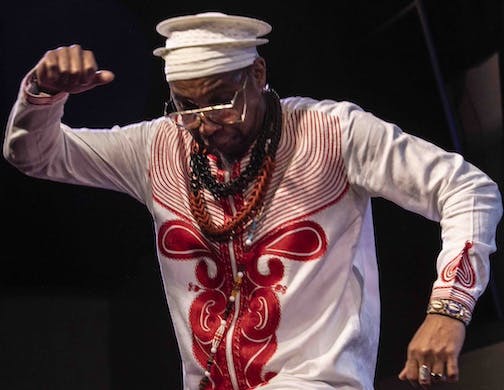Diversity Is the Name of the Game as Omar Sosa Quarteto Americanos Graces Birdland
Sosa’s notion of diversity includes moving between different styles of jazz associated with different parts of the globe, and an easy alliance between acoustic and electronic instruments.

Omar Sosa Quarteto Americanos
Birdland
Through April 13
Omar Sosa & Paolo Fresu
‘Food’
Tuk Music, 2023
The first thing one reads about Omar Sosa is that he is “a jazz pianist from Cuba,” which is not quite the same thing as a “Cuban jazz pianist.” Mr. Sosa was born in Cuba in 1965, but Afro-Cuban jazz is one of many styles that he plays in.
In fact, for Mr. Sosa, multi-stylistic virtuosity comprises a style unto itself. He calls his current ensemble “Quarteto Americanos,” and perhaps that’s telling us something right there: It’s a presumably North American-style group, but it’s named en espanol. Even the band’s title is a signifier of diversity.
The significance of that signifier isn’t merely that the band plays various pieces of music in different styles, but rather that it often makes transitions between approaches within a single piece — turning on a dime, as the old expression goes.
Generally the segways are signaled by the reed player Sheldon Brown, as he switches between four different horns. Drummer Josh Jones and bassist Ernesto Mazar Kindelán, playing an electrified “stand-up” instrument — the kind often seen in Latin bands and that he calls a “baby bass” — fill out the quarteto.
The first show on Tuesday started with a few rubato notes on the piano, and Mr. Sheldon seemingly noodling around on bass clarinet; the tempo was undefined, and the melody rambled without any clear sense of direction. Not for long, though: The piece, titled “Bola” gradually came into focus, thanks especially to the assists of Messrs. Kindelán and Jones. It mounted in intensity, reaching the point where the foursome was charging full speed ahead.

The second piece, “D2 de Africa,” started as a duet between Mr. Brown’s soprano sax and Mr. Sosa’s keyboards; on the whole, it was faster and more staccato, but at key points it also slowed down and became more expansive. Where the bass clarinet establishes a languorous, relaxed mode, the soprano sounds chirpier and more aggressive, punching in with short stabs of notes.
Mr. Sosa’s notion of diversity includes moving between different styles of jazz associated with different parts of the globe — Latin America, Africa, North American-style bebop — but also an easy alliance between acoustic and electronic instruments. His setup includes three keyboards: Birdland’s familiar Yamaha, an electric piano, and a small synthesizer, all of which combined on this second piece.
The program was all original works by Mr. Sosa, none of which stood still for very long. He continually shape-shifts between approaches — with Mr. Jones switching from American traps to Latin bongos as necessary, as on the third piece. This started as a kind of mystical incantation, and eventually incorporated a pre-recorded vocal track that was equal parts chant and rap.
At points, the foursome reached what we would think of as true Afro-Cuban jazz, with Mr. Brown on tenor saxophone and the rhythm section playing en clave. The crowd responded most enthusiastically during these moments, but it was never gratuitous; rather Mr. Sosa seemed to feel that he wanted to make both the musicians and the crowd earn these moments by building up to them gradually and organically.
There also were moments with Mr. Brooks playing a very aggressive kind of 1960s tenor in a style related to John Coltrane or Wayne Shorter. To get even more worldly, or even other-worldly, Mr. Brown also employed a highly unusual metal clarinet, pitched in G and made in Turkey.
In an age when even the most prominent musicians have a hard time making records, Mr. Sosa consistently has a new release, the latest of which is “Food,” an impressive set of mostly duets with the Italian trumpeter Paolo Fresu. He’s also represented by a new documentary about his life and music, “Omar Sosa’s 88 Well-Tuned Drums,” and an accompanying soundtrack LP of the same title.
One advantage of the film, which I’m looking forward to seeing, is to hear Ms. Sosa speak at length about his music, which is the opposite of what he does on stage at Birdland, opening his mouth only briefly to introduce the members of the quarteto.
These days, it’s a common-enough metaphor to describe a musical performance as a kind of a “journey.” With Omar Sosa Quarteto Americanos, we feel like we’ve been all over the world in less than 80 minutes, coming back to Birdland just in time to pay our checks.

